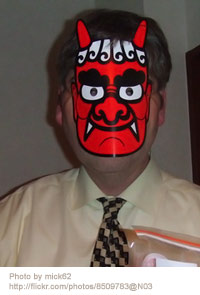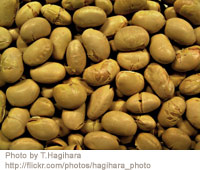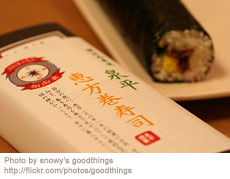In our series of Japanese culture, we have now come to the next article by Shizu, “Setsubun is coming up. Devils, watch out!”, describing the Japanese traditions surrounding what the Japanese call Setsubun.
If you look at the Japanese calendar, you may find the word 立春 (りっしゅん – risshun) under the date 4th of February. The latter kanji 春 (はる – haru) means “spring”, and 立春 (risshun) “the beginning of spring”. Of course real spring is still far away then, unless you live in a southern area like Okinawa; at least here in Hokkaido there are still more 吹雪 (ふぶき – fubuki – snow storms) to fight our way through (lol). Apart from that, 春 indicates the beginning of the new season/year, and actually 立春 is New Year’s Day according to 旧暦 (きゅうれき – kyuureki – old calendar).
Well, you must notice another word 節分(せつぶん – setsubun) on the 3rd of February. 節(せつ – setsu) means 季節(きせつ – kisetsu – season), and 分(ぶん – bun) means dividing, namely it means that the day 節分(setsubun) divides the new and old years. So, you can regard this day as 大晦日(おおみそか – oomisoka – New Year’s Eve), needless to say by the old calendar.
 On the night of 節分 (setsubun), we do 豆撒き(まめまき – mamemaki). 豆(まめ – mame) refers to beans, and the word 豆撒き(mamemaki) means “scattering beans”. But actually, your action is throwing beans at 鬼(おに – oni) though. Around this season, you can see some bags of beans at supermarkets, and some bags might have a paper mask of 鬼 . If you like reading Japanese old tales, 鬼 often appears in the hero stories like 桃太郎 (ももたろう – Momotarou). 鬼 is often translated as “demon”, and it’s a symbol of “bad things”. In the event 節分 (setsubun), we should drive 鬼 (oni) out of the house, and we use the 豆.
On the night of 節分 (setsubun), we do 豆撒き(まめまき – mamemaki). 豆(まめ – mame) refers to beans, and the word 豆撒き(mamemaki) means “scattering beans”. But actually, your action is throwing beans at 鬼(おに – oni) though. Around this season, you can see some bags of beans at supermarkets, and some bags might have a paper mask of 鬼 . If you like reading Japanese old tales, 鬼 often appears in the hero stories like 桃太郎 (ももたろう – Momotarou). 鬼 is often translated as “demon”, and it’s a symbol of “bad things”. In the event 節分 (setsubun), we should drive 鬼 (oni) out of the house, and we use the 豆.
This noisy ceremony takes place as follows: First of all, someone should play 鬼 (mostly the father of the family does), and this poor person puts on the paper mask. We leave open the window in the room for the ceremony, and 鬼 stands in front of the window. The rest of the family members hold beans in their hands, and throw them at 鬼 while crying the chant:
鬼は外
oni wa soto
福は内
fuku wa uchi
The chant means “demon (or bad things) is outside, happiness (or good things) inside” or something like that. The person being 鬼 is hit by such bean storms repeatedly, but he mustn’t get away from there. When I was a little child, this event used to delight 母(はは – haha – my mother) a lot, and 父(ちち – chichi – my father) once told her, “Hey, don’t do it so seriously!”, lol. Of course this event is not for teasing him. It expresses our hopes for the family’s good health and other happy things in the new season/year.
 After the ceremony, we eat 豆 (mame – beans). As the custom, however many years old you are, you eat that many beans. Personally I don’t like beans too much, but this rule isn’t pleasant for lots of 子供たち(こどもたち – kodomotachi – children), and 祖父母 (そふぼ – sofubo – grandparents) might try to share theirs with the 孫 (まご – mago – grandchildren). According to a friend of mine, who lives in another prefecture, parched 大豆(だいず – daizu – soy beans) were originally used for 節分(setsubun). But actually, different kinds of “beans” are sold here in Hokkaido as 豆(mame) although they’re just snacks containing nuts.
After the ceremony, we eat 豆 (mame – beans). As the custom, however many years old you are, you eat that many beans. Personally I don’t like beans too much, but this rule isn’t pleasant for lots of 子供たち(こどもたち – kodomotachi – children), and 祖父母 (そふぼ – sofubo – grandparents) might try to share theirs with the 孫 (まご – mago – grandchildren). According to a friend of mine, who lives in another prefecture, parched 大豆(だいず – daizu – soy beans) were originally used for 節分(setsubun). But actually, different kinds of “beans” are sold here in Hokkaido as 豆(mame) although they’re just snacks containing nuts.
By the way, recently another new custom is spreading instead of this 豆撒き (mamemaki), I hear. Maybe you know 寿司 (すし – sushi), and we eat one of them called 太巻き (ふとまき – futomaki). The adjective 太い (ふとい – futoi) means “fat”, and 太巻き (futomaki) is a sushi consisting of some fillings and vinegared rice wrapped in 海苔(のり – nori – seaweed), which looks like black paper. The ones which are eaten on the night of 節分 (setsubun), we call 恵方巻き(えほうまき – ehoumaki), and there are seven kinds of filling, which is a lucky number.
Well, I wrote “new custom” in above, but actually this custom began around the end of 江戸時代 (えどじだい – edo jidai – the Edo period) in Kansai areas like Osaka and Kyoto, I hear. Normally 太巻き (futomaki) is served after being sliced, but you eat the whole 恵方巻き (ehoumaki) in one piece, and you should be silent while eating it. The most important point is that you eat it while facing in a direction that happiness comes from. This year it’s 南南東 (なんなんとう – nan nan tou – south-southeast). Eating 恵方巻き (ehoumaki) also spread here to Hokkaido in recent years, but we didn’t know about this strange and funny custom until lately. A friend of mine has relatives in another prefecture, and once she happened to stay at the night of 節分 (setsubun) with them. They were enjoying talking, and then suddenly everyone stood up and looked in the same direction, and began eating the 太巻き (futomaki) on the table in front of them, and continued silently. She was really astonished by that – it’s funny to imagine her surprise.
 Also this custom is similar to the 豆撒き (mamemaki) ceremony. It means, we wish for happiness in the new year by eating 恵方巻き (ehoumaki) on the night before. But in lots of areas where the eating custom spread without the meaning of 節分 (setsubun), some things are ignored; for example, the number of filling materials of the 恵方巻き (ehoumaki), sweet rolled cake instead of sushi etc. Nobody might complain about your not knowing the meaning of a tradition, but at least learning it is interesting, I think.
Also this custom is similar to the 豆撒き (mamemaki) ceremony. It means, we wish for happiness in the new year by eating 恵方巻き (ehoumaki) on the night before. But in lots of areas where the eating custom spread without the meaning of 節分 (setsubun), some things are ignored; for example, the number of filling materials of the 恵方巻き (ehoumaki), sweet rolled cake instead of sushi etc. Nobody might complain about your not knowing the meaning of a tradition, but at least learning it is interesting, I think.
Kanji and Vocabulary
Here are some kanji, related to seasons, that may be good to know:
- 季節(きせつ – kisetsu – season)
- 春(はる – haru – spring)
- 夏(なつ – natsu – summer)
- 秋(あき – aki – autumn)
- 冬(ふゆ – fuyu – winter)
- 旧暦 (きゅうれき – kyuureki – old calendar)
暦 (こよみ – koyomi) means “calendar”, but saying カレンダー (karendaa) is much common now, and the word 暦 (koyomi) often indicates the Japanese style calendar, which contains lots of mysterious words on each day, as opposed to the western style calendar.
巻寿司 (まきずし – makizushi) – It’s a kind of sushi. Some fillings (cucumber, Japanese style omlette, cooked fish, sweet vinegared ginger, etc.) and vinegared rice are wrapped in nori (seaweed). There are 太巻き (ふとまき – futomaki) and 細巻き (ほそまき – hosomaki) mainly. The adjective 細い (ほそい – hosoi) means “thin, slim, slender”, and the 細巻き includes only one kind of filling.